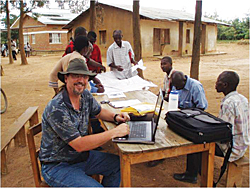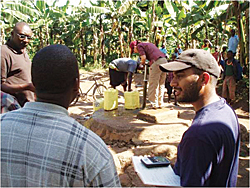ArcUser Online
Clean drinking water is hard to find in Mayange, Rwanda. That's why a group of university students and two professors from the University of Redlands (U of R) in California traveled there. Using the GIS technology and GPS equipment they brought along, they mapped the area's water sources and collected water use information. Their survey will help improve access to clean drinking water in Mayange and in similar communities across sub-Saharan Africa. The maps will provide local sustainable development programs with accurate information on where people get their water. For example, the data can be used to identify areas where water sources are contaminated and support decisions about improving water quality such as how to protect an open pit water source or where to dig a new water source. Ultimately, this field collection and mapping model may be used for mapping other water networks in Rwanda and parts of Africa and contribute to the implementation of sustainable practices in impoverished nations.
"Anything that we can do to improve water quality is going to have a major impact on the population," said Max Baber, Ph.D., associate professor in the master of science in Geographic Information Science program at the U of R. Baber and Katherine Noble-Goodman, a visiting lecturer in environmental studies at the university, led U of R undergraduate environmental studies students to the rural Mayange sector in 2008 and 2009. In the bigger picture, the project contributes to the Millennium Development Goals (MDG)—an ambitious plan that pledges to eliminate extreme poverty worldwide by 2015. Representatives from 192 United Nations (UN) member states signed on to the MDG commitment to reduce poverty by improving health, education, agriculture, and infrastructure. Access to clean drinking water plays an important part in supporting these goals. MDG aims to reduce by half the proportion of people without sustainable access to safe drinking water. Some progress has been made in advancing MDG goals, but in sub-Saharan Africa, improvements have advanced more slowly than in other parts of the world. As a result, the Millennium Villages Project (MVP) was established to create a successful model in Africa for alleviating poverty using a set of integrated, community-driven activities. Mayange, with a sector population of 25,000, is one of 80 communities spread across 10 African countries that are participating in MVP. Located in one of the poorest regions in Rwanda, the area is almost completely deforested and receives 800 millimeters (about 31.5 inches) of intermittent annual rainfall. As in many other rural African areas, Mayange villagers spend hours each day retrieving water their families need to survive. Often the water source is contaminated. This can cause health problems. The time-consuming process of obtaining water also diverts efforts from activities crucial to sustainable development such as education and farming. "Clean, reliable sources of water for drinking, cooking, and other basic human needs are a necessary condition for the elimination of poverty and the success of sustainable development," said Noble-Goodman. In Rwanda, more than 25 percent of the population lacks access to clean water.
Using GPS equipment and ArcGIS, the teams spent a total of 15 days in May 2008 and 2009 in the field mapping and classifying water access points such as wells, lakes, and cisterns. With help from local village leaders and guides and personnel from Rwanda National University and MVP, the students built a database of water sources by collecting GPS points in the field and classifying each site as a shallow well, open pit, lake, deep borehole, water tap, or cistern. The team also collected survey data by talking with individuals who arrived at the sites to fill their water cans. The survey provided information on water use, household location and size, distance to the water source, and the seasonal availability of water. The survey's purpose was to help MVP participants prioritize areas in most need of improving the quality and quantity of water sources. "One goal of MVP is to have water within one kilometer of every household. This is very ambitious and will take a while," said Molly Moore, a U of R student who participated in the project. The data is being held by Didace Kayiranga, MVP science coordinator in Mayange. "It gives us tools for planning and to evaluate our indicators such as distance from a household to a clean water source," said Kayiranga. "This indicator cannot be easily measured without overlaying the different household and water point layers." The GIS fieldwork gave students hands-on experience to learn how GIS technology can support projects that study the relationship between humans and the environment. "And for a few days in May," said Noble-Goodman, "students had the opportunity to help improve the community's access to clean, safe drinking water."
"Working in an extremely rural, undeveloped area also provided new lessons" said Baber. "Students learned about the nature of uncertainty in collecting GIS data, such as mapping a community that does not have an address system and issues that can cause deterioration of the accuracy of GPS readings." U of R faculty and students continue to edit and revise the project data in graduate GIS classroom studies as a way to explore the spatial dimensions of public health issues. They are running analyses and creating spatial models to predict relative likelihood of productivity for new borehole well site locations. In the most commonly employed model, inputs are derived from household density (as analog for population density so that proximity to population concentrations is incorporated in the model) and relative terrain situation (valley or ridge, for relative proximity to groundwater). For this project, U of R collaborated with Loma Linda University School of Public Health (www.llu.edu/llu/sph/), National University of Rwanda Geographic Information Systems and Remote Sensing Centre (www.cgisnur.org), and the Millennium Villages Project (www.millenniumvillages.org). Grant money was provided by the Southern California Metropolitan Water District through a program that challenges students to develop water-conserving technology in impoverished nations. To learn more about the students' mapping project, contact Max Baber at max_baber@spatial.redlands.edu. |

